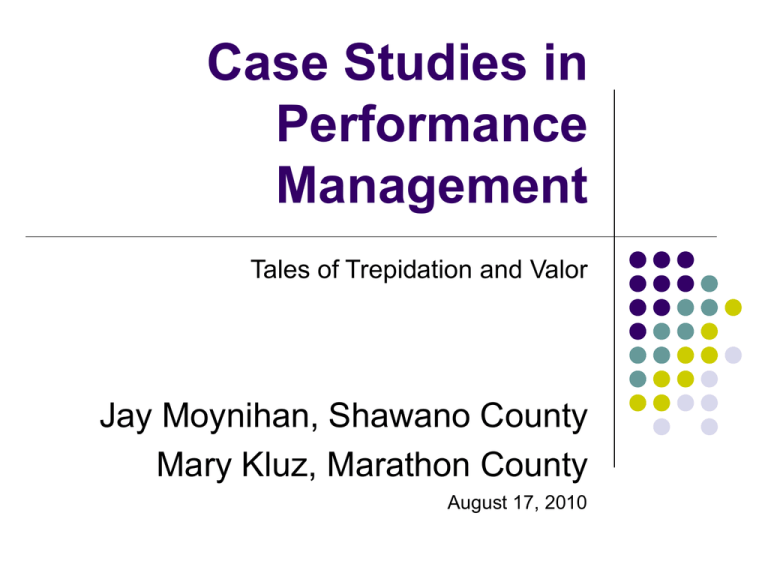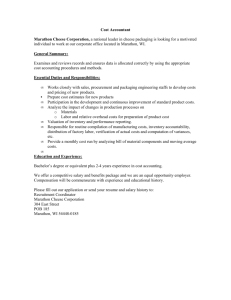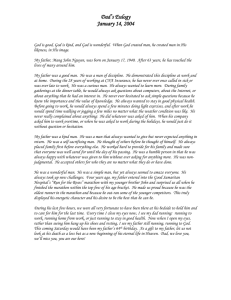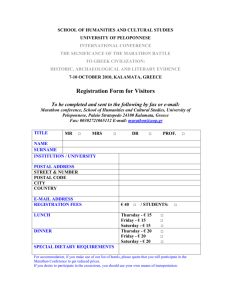Case Studies in Performance Management Jay Moynihan and Mary Kluz
advertisement

Case Studies in Performance Management Tales of Trepidation and Valor Jay Moynihan, Shawano County Mary Kluz, Marathon County August 17, 2010 A tale of two counties… Shawano County & Outcome Based Management & Budgeting An Exercise in friction* My experience so far with Outcome Based Management & Budgeting… • How it started What I did What happened (or did not happen) “The force that makes the apparently easy so difficult.” Carl von Clausewitz Start In late 2006 the Administrative Coordinator and I began discussing educational possibilities regarding public finance and management. He was curious about “performance based budgeting”. Start I did some research, talked to the folks at the Local Government Center….. And came up with County Governance element for my 2007 Plan of Work. Part of that programming turned into “Outcome Based Management & Budgeting”… In my county financial management and budgeting is a “Wicked Problem” The concept of "wicked problems“ was proposed by Horst Rittel University of California, Berkeley Rittel, H., and M. Webber; "Dilemmas in a General Theory of Planning“ Policy Sciences, Vol. 4, pp 155-169 (1973) When is a problem “Wicked” ? The problem is not understood until after formulation of a solution. Stakeholders have radically different world views and different frames for understanding the problem. Constraints and resources to solve the problem change over time. The problem is never solved. The Admin. Coordinator & the Finance Director recommended starting with the department heads as an audience. With the assistance of Alan Probst (who was working on the first versions of his materials on PBB/PBM at the time), I developed some presentation and reference materials. Did a morning-long workshop for department heads on July 27, 2007. Outcomes We start and finish with outcomes. Results matter. In many respects, outcomes drive the performance measurement system. In order to clearly define your outcomes or desired results, first determine why you do what you do, and next determine how your particular agency program or service benefits your customers and what value it provides them? Post workshop End outcomes are predicated on surveys showed a wide level of two vital components: 1) Outcome goals (benefits) interest, but a strong hesitancy 2) Outcome performance measures to buy in, and a lot of it-willnever-work-here… From Fairfax county Virginia training manual Outcomes: the direct results or benefits for citizens. Next: We put on a workshop featuring the Administrator of Eau Claire County & and one the county department heads-----Actually he picked the Extension head to bring along, since they where an early test group… Eau Claire County was at that time about 5 years into a slowwwwwwwww implementation of performance based budgeting. Our Admin Coordinator and Department heads decided to start with a couple volunteer departments… Volunteers did not rush forward…… We are into 2008, now……….. One department may be interested, its director is interested in outcome based tools…… But then, a presentation for the county’s Administration Committee Committee: Ok to spend time on it, with departments, if it does not interfere with their duties. Friction Summer 2008, a period of significant discord between some key people in the government. No Champion on board or staff Admin coordinator….it is a weaker position than an exec or administrator X Friction X X Landscape features: • A large county board (30) (higher complexity) • Strong influence lines between home committees/departments (complexity) • Strong desire by many supervisors to maintain decision making on non-policy details And then in later 2008… In mid 2008……………Recession From: http://timinglogic.blogspot.com/2010/04/geithner-wall-streets-primary-regulator.html Some of what I learned… A lot about local “ground effect” and friction patterns. I need perhaps to spend more time on education about why a government may want to plan and other governance matters….? In the absence of a strategic plan or the desire to do one, really try to do that in a department, then OBMB in there, to create an example? Outcome Measurement in Marathon County What is our Return on Public Investment? MIDWEST GOVERNMENT PERFORMANCE CONFERENCE October 2007 Presenters… A couple of Marathon County deputies Brad Karger Deputy County Administrator Nicole DeBettignies Deputy Social Services Director Why measure outcomes? Because… We increase our chances of achieving our goals. The outcome data tells us how we are doing. Taxpayers are demanding RESULTS. Builds faith in government. Budget proposals need justification. It leads to informed decision making. Factors Leading to Outcome Measurement in Marathon County Conversation between administrator and staff member about water quality in the Rib River Watershed. Marathon County United Way’s change from program allocations to community investments. Formation of a staff leadership team with the goal of developing a data base to strengthen County programs. Federal Government Accountability Act. How has Marathon County benefited from measuring outcomes: Increasing service effectiveness (strengthening our programs) Communicating program value Outcome Measurement Oversight Team Mission: To provide leadership for creating an outcome measurement process. This will enhance decision-making, accountability and continuous improvement of our public services. Oversight Team Members Qualifications: A genuine commitment to the mission of the team, the willingness to serve up to four hours per month for a twoyear period. Permanent membership will come from the three largest departments and the Finance Department. New members will be expected to complete an educational program on outcome measurement, approximately four hours in length. Oversight Team Activities continued… In summary, the team’s purpose is to: Support organizational learning Encourage program improvement Factors contributing to success Commitment by an influential champion Communicating an understanding of how this piece fits into the broader environment How the organization benefits from the effort A willingness to play with ideas Leadership Philosophy of Alignment Mission: Why we exist. Vision: Description of future success. Core Values: What we believe in. Strategy: The pathway to achieving organizational success. Leadership: People relied upon to set direction. Structure: Reporting relationships, systems designed to support operations. Outcome Measurement can be a tool to answer the question: SO WHAT? Another way to think about that question is: “Return on Public Investment” Logic Model Template Department/Program Name: Contact Name: Brief program description: Mission: Program customer: Inputs resources Activities actions Outputs count Initial Outcomes learning Intermediate Outcomes action Long-term Outcomes community benefit County Board’s overarching goals What we do What customers do A WILLINGNESS TO PLAY WITH IDEAS Translation: we are making this up as we go along Measurement Plan Template: educational tool, used one year MEASUREMENT PLAN SUMMARY The following is a format for submission of your measurement system. For the first year of measuring outcomes please choose one outcome to measure. We are requesting a plan for measurement, not the resulting data. (Chosen outcome restated from logic model) 1. indicator #1: By (date), (target) a.Data source: (state which audience will receive the measurement tool and what kind of tool will be used) b.[Data source: (you may choose to use more than one source, record any others)] 2. indicator #2: you may state another indicator which provides evidence that the outcome is happening. Format any additional indicators the same as above for indicator #1. Measuring this will help strengthen this program by ___________________________ _____________________________________________________________________ Reporting Template: educational tool, used several years Outcome Measurement Report Department/Year Program Information: Program Outcome: Expected indicators: Outcomes achieved: What did you learn about your program based on this outcome? What will you do with the outcome information and will you make any changes to the program? Example of Logic Model: June 2010 Who we are / What we do: what we invest: Sheriff’s Dept Educate and enforce learning Highway Dept Understand Seek more permit process permits Educate and permit Conservation Educate and Planning, Zoning consult action Understand Fewer consequences violations Learn about alternative practices Change practices Community benefit Marathon County maintains a safe and reasonable standard of transportation infrastructure. Can you see the usefulness of using a logic model to think about the value of a program? Strengthening program Communicating value Is it clear why we might want to expand our view to include outcomes? (We are promoting an expanded view of County programs which includes outcomes -not a view that ignores inputs, activities and outputs. All are important and need to be monitored.) Administration’s intention to use outcome data to… Respond to public’s demand for accountability. Trigger corrective action. Motivate staff; use as basis for ‘how are we doing” meetings; reward high performing offices or employees. Help in planning and budget decision making. Communicate better with the public, build public trust. Improve organizational performance. Lessons learned on the journey . . . . A few references Marathon County’s mission & vision http://www.co.marathon.wi.us/organizational excellence.asp Marathon County 2010 budget http://www.co.marathon.wi.us/is/mcf/pdf/final 2010budgetbook.pdf Urban Institute outcome indicators project http://www.urban.org/center/cnp/projects/out comeindicators.cfm National Performance Management Advisory Commission http://www.pmcommission.org/APerformance ManagementFramework.pdf



